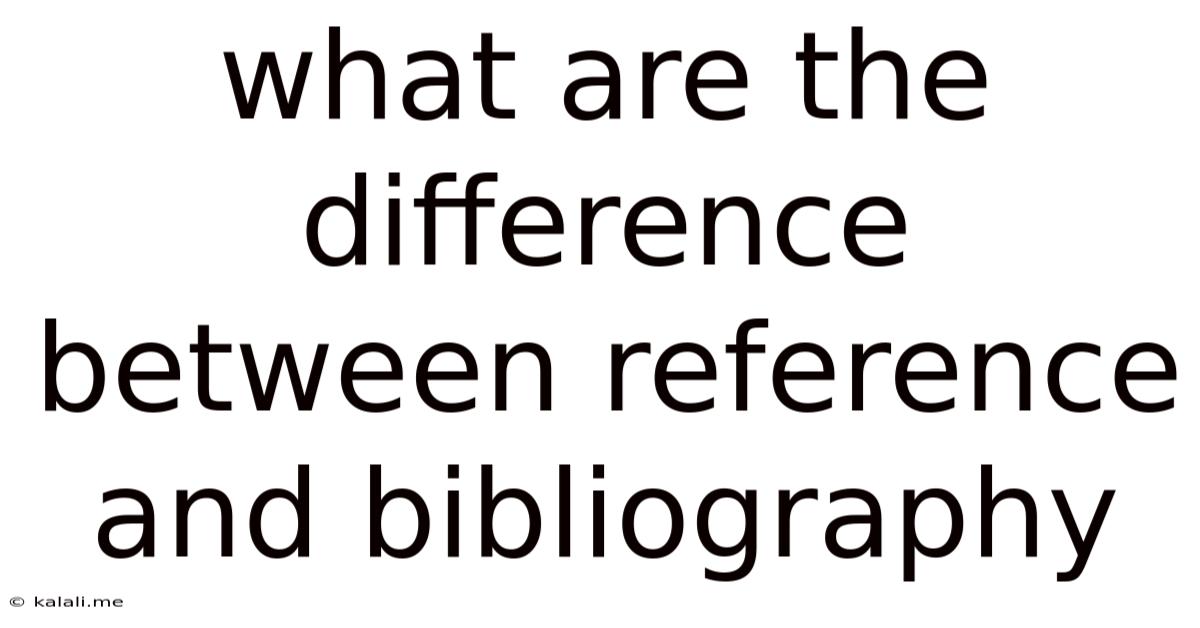What Are The Difference Between Reference And Bibliography
Kalali
Jun 11, 2025 · 3 min read

Table of Contents
What's the Difference Between a Reference List and a Bibliography?
Knowing the difference between a reference list and a bibliography is crucial for academic writing and proper citation. While both list sources used in a research paper or other academic work, their purpose and content differ significantly. This article clarifies the distinction, helping you avoid common mistakes and ensure accurate academic referencing.
Understanding Reference Lists:
A reference list is a comprehensive list of only the sources directly cited within the body of your work. It includes specific details enabling readers to easily locate each source. Think of it as a precise record of the evidence you've used to support your arguments. This is the most common style requested by academic institutions and professional publications. The formatting strictly adheres to a specific citation style (e.g., APA, MLA, Chicago). Each entry provides:
- Author(s): Last name, first initial(s).
- Year of Publication: In parentheses.
- Title of Work: Italicized for books, articles, etc.
- Publication Details: Journal name, volume, pages; publisher, location, etc. These details vary based on the citation style.
Key Characteristics of a Reference List:
- Only cited sources: No extra readings or background research is included unless directly referenced in the text.
- Strict formatting: Follows a particular citation style guide meticulously.
- Alphabetical order: Usually arranged alphabetically by the first author's last name.
- Accuracy is paramount: Any errors can lead to difficulties in locating the source.
Understanding Bibliographies:
A bibliography is a broader list encompassing all sources consulted during the research process, regardless of whether they were explicitly cited in the text. It can include books, articles, websites, interviews—essentially, anything that contributed to your understanding of the topic. Think of it as a comprehensive overview of your research journey.
Key Characteristics of a Bibliography:
- All consulted sources: Includes both cited and uncited materials.
- Less strict formatting: While consistency is important, it's typically less rigid than a reference list.
- Organization: Can be alphabetical, chronological, or thematic, depending on the context and the author's preference.
- Provides context: Shows the breadth of your research and the resources you explored.
The Crucial Difference Summarized:
| Feature | Reference List | Bibliography |
|---|---|---|
| Sources Listed | Only those directly cited in the text | All sources consulted, cited or not |
| Purpose | To provide verifiable evidence for claims made | To showcase the scope of research undertaken |
| Formatting | Strict adherence to a specific citation style | Less strict, more flexibility in format |
| Ordering | Usually alphabetical by author's last name | Alphabetical, chronological, or thematic |
When to Use Which:
Most academic assignments require a reference list, not a bibliography. However, a bibliography might be suitable for projects where demonstrating the breadth of your research is as important as citing specific evidence, such as a literature review or a comprehensive research proposal. Always check your assignment guidelines for specific instructions. Following the correct format is key to demonstrating academic integrity and presenting your work professionally.
Latest Posts
Latest Posts
-
How Many Fluid Ounces In A Half Gallon
Jul 01, 2025
-
How Many Chicken Thighs In A Pound
Jul 01, 2025
-
How Old Is Someone Born In 1992
Jul 01, 2025
-
How Many Grams Is In A Pint
Jul 01, 2025
-
Lyrics To The Song Stand By Donnie Mcclurkin
Jul 01, 2025
Related Post
Thank you for visiting our website which covers about What Are The Difference Between Reference And Bibliography . We hope the information provided has been useful to you. Feel free to contact us if you have any questions or need further assistance. See you next time and don't miss to bookmark.